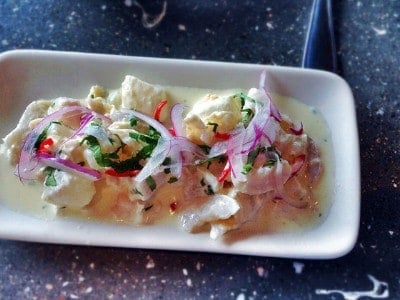
Peruvian cuisine is known for its ceviche.
This popular seafood dish originates in Lima, Peru…,
… but can also be found in coastal areas throughout Latin America…
…including Ecuador, Chile, Mexico, and Colombia.
Various spellings of ceviche exist, including cebiche and seviche.
Ceviche consists of raw fish and lime juice mixed with chilies, or hot peppers.
“Ceviche could have got its name from several places. There are arguments to suggest that it derives from the Latin ‘cibus’, which means ‘food for men and animals’ and potentially from the Arabic words for soup or vinegar. Another favoured theory is that it originates from the Spanish word ‘escabeche’ which literally means pickle or marinade. ”
Sheree Hooker – Writer, Travel Blogger
Our focus is on Peruvian ceviche (Peru’s national dish)…
…but the method, ingredients, and preparation are similar…
…to other forms of this dish, such as ceviche Mexicano…
…or ceviche with prawns or octopus.
Here is Meeve’s story as we move on to the next section…
When I was young and wild, I worked in a restaurant
that served Mexican street foods for free.
There were plenty of tacos and tamales available,
as well as the obligatory guacamole at the table.
It was, however, the made-to-order ceviche that captured my attention.
Compared to the spice-laden moles and slow-cooked barbacoa,
they made the case that, in some cases, stark freshness
can be more poetic than a bunch of heavy-handed kitchen cooking.
Now, let’s jump right in!
History of Ceviche
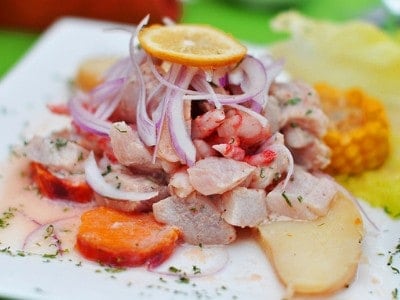
There is a theory that ceviche originated…
…with the Moche of Peru some 2000 years ago.
Moche raw seafood was marinated in fermented juice…
…from local banana passionfruits.
When the Spaniards arrived, they slightly modified the dish.
As local populations adapted ceviche recipes…
…ceviche spread to other Latin American nations.
History has recently revealed that fish was marinated in chichi…
…an Andean fermented beverage, during the reign of the Incas.
However, this is only one theory regarding the origin of this much-loved food.
“Ceviche” may come from a number of sources.
Citrus can come from Latin terms meaning both food for people and animals.
It may also come from Arabic, which means vinegar or soup…
…or even the Spanish word escabeche, which means pickle.
Ceviche may also be spelled seviche or cebiche.
These words have the same pronunciation in Spanish.
Keep reading…
Authentic Peruvian Ceviche Ingredients
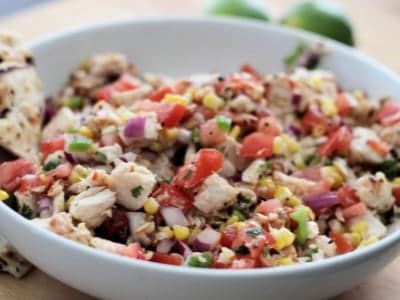
While ceviche recipes have spread to countries…
…all over the Caribbean, Peru claims to be the originator.
Ceviche fans are familiar with Gaston Acurio.
A Peruvian chef made this dish famous by touting its traditional flavors.
In his restaurants in Peru and throughout the New World…
…he also prepared several varieties of ceviche.
Ceviche would probably remain a regional dish in South America without Acurio.
There are three ingredients you must include…
…in this Peruvian treat, according to Acurio.
- Raw fish is the first thing you need. You can use any type of fish, but traditional dishes call for sea bass or shark. In ancient Peru, these fish were caught from the ocean and served as ceviche after being brine-cured with salt. Before adding liquid, you chop the raw fish into tiny chunks.
- Citrus juice is the next ingredient you will need. Since the Spanish imported limes around 400 years ago, the traditional ceviche recipe uses fresh lime juice (or lemon juice). Until limes came around, ceviche consisted of raw fish, salt, and chili peppers.
- The third ingredient you’ll need is an aji (pronounced “ah-hee”) chili pepper. These yellow and orange peppers grow throughout Peru. On the Scoville scale, yellow aji chilis score between 40,000 and 50,000 on the hotness scale. As a comparison, jalapeo peppers are 2,500 to 8,000 Scoville units. Peru has several varieties of aji, ranging in hotness from mild to hot. They’re also a good source of vitamin C.
Go on…
Cooking Ceviche
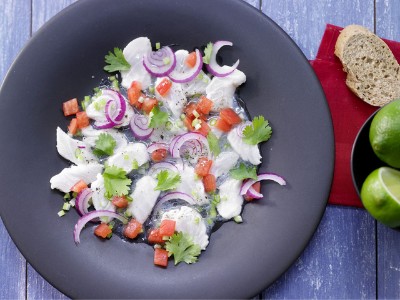
The normal process of cooking food involves denaturing…
…which refers to the modification of the structure of the proteins in the food.
You may have seen this in the case of cooking an egg…
…and seeing the ‘white’ change from a clear to solid color.
Citric acid is another method of denaturing a protein.
Raw fish or any raw seafood is essentially denatured by citrus juices.
Ceviche cooking time is an important factor to consider.
Some chefs leave the fish in the juice for a minute…
…while others prefer 10 minutes or more.
Fish can become rubbery if “cooked” or marinated…
…in lime juice for a long period of time.
Fresh fish must also be of high quality…
…since marination will not kill all bacteria the same way heat will.
Before marinating the fish, you can quickly cook it in boiling water.
Since many pathogens cannot survive…
…in the acidic environment of the marinade, but others can…
…it is especially important to choose fresh fish of high quality.
Fresher fish has a better taste and is less likely to have diseases.
A good way to ensure the raw fish is cooked is to cut it into smaller pieces.
Consider experimenting with marination times since longer cooking times..
…can adversely affect flavour. Fruit juices can overpower the natural flavor of fish.
A strong citrus marinade can easily ruin the delicate…
…fresh flavor of a high-quality fish.
For ceviche, use the following types of fresh fish:
- Sea Bass
- Grouper
- Halibut
- Sole
- Bream
- Polack
- Flounder
Although some chefs serve ceviche with salmon…
…oily fish are generally not recommended for ceviche.
Spaniards introduced Peruvians to red onions at the same time they introduced limes.
If you want to use other ingredients, feel free to do so.
To give ceviche a little taste, you can marinate it with clam juice.
Peruvian ceviche chefs experiment …
…with denaturation in order to create the perfect dish.
Citrus juice and fresh fish meat undergo a chemical reaction called denaturation.
The acid changes the meat’s composition.
Instead of a soft, pliable flesh, the fish becomes firm and opaque…
…looking just like it has been cooked.
Many centuries ago, the Moche people put fish in a salt bath for many hours.
Until the 1970s, fish was often soaked in lime juice…
…for a long time before it was served to hungry guests.
Eventually, Peruvian chefs realized…
…short marinating times would be more convenient.
Small chunks of fish bathed in lime juice…
…for a few minutes made the outside of the fish firm…
…while the inside remained soft and tender.
Make no mistake. Lime juice does not cook meat the way heat does.
Lime juice doesn’t completely kill bacteria either.
In order to prepare the dish, fishmongers and fish experts choose fresh…
…contaminant-free fish. Fish that has not been handled properly…
…or that is not fresh should not be used.
The acid in the lime is perfect for denatured fish.
There is no comparison between oranges, grapefruits, or lemons.
If you want a true taste of Peru, add some squeezed passion fruit to the marinade.
If you want a hearty, nutritious meal without a lot of effort, ceviche is perfect for you.
Our Articles About Ceviche
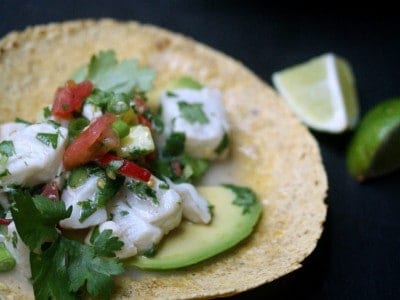
Halibut Ceviche with Mango and Avocado Recipe For You!
Light, tangy, and refreshing halibut ceviche with mango and avocado!
It’s the ideal summer appetizer or light entree…
…and it’s incredibly simple to prepare!
It became unbearably hot here all of a sudden!
April was cold, then May was rainy, and now it’s hot and humid.
Spring had barely arrived when we jumped right into no-cook meals!
Here’s one of my go-to summertime recipes that doesn’t require any cooking!
Mango and Avocado Ceviche with Halibut.
Special Tilapia Ceviche Recipe You Need To Know!
Tilapia Ceviche is a tangy, tart, and flavorful Central and South American appetizer.
Lime juice is used to “cook” tender whitefish…
…which is then served with salty pastry cups. Your taste buds will be ecstatic.
Ceviche is a South American and Central American dish.
Its origins are a point of contention among Central and South American nations.
Read the article to find out the recipe!
Delightful Best Fish For Ceviche
Ceviche is best made using white, crisp, flaky fish…
…because the texture allows the flavors to penetrate….
….more quickly. Snapper, sea bass, halibut, mahi-mahi,
…fluke, flounder, red snapper, halibut, and sashimi-quality tuna…
…are among the best seafood for ceviche.
Some recipes call for adding shrimp, scallops, squid,
…or octopus to the mix. To ensure food safety…
…when utilizing shrimp or other shellfish,
blanch them cook in boiling salted water until opaque…
…then dip into cold water to cool.
Sum Up!
Ceviche is something of a Latin American seafood dish…
…that is sometimes spelled cebiche…
…or seviche depending on the region where it originated.
Having an understanding of ceviche’s origin offers us a deeper understanding…
…of many South American countries, especially Peru…
…where it has assumed the position of national dish.
Conclusion
Ceviche (pronounced say-beach-chay) is a common dish…
…across Latin America and is a must-try for travelers.
Whether you order it in a fancy restaurant…
…or from a South American street food cart…
…you are certain to fall in love with it!
Our Latest Post:
- Zest Up Your Dishes: Exciting Substitutes For Lemongrass Unveiled!
- Why Your NutriBullet Stopped Working – Unveiling Solutions
- Griddler Showdown: Cuisinart Griddler Deluxe vs Elite – Which is Better?
💻Peruvian-Style Flounder Ceviche | Halibut Ceviche| Special Tuna Ceviche
Was this helpful?
Hi there! I’m a food enthusiast and journalist, and I have a real passion for food that goes beyond the kitchen. I love my dream job and I’m lucky enough to be able to share my knowledge with readers of several large media outlets. My specialty is writing engaging food-related content, and I take pride in being able to connect with my audience. I’m known for my creativity in the kitchen, and I’m confident that I can be the perfect guide for anyone looking to take their culinary journey to the next level.








